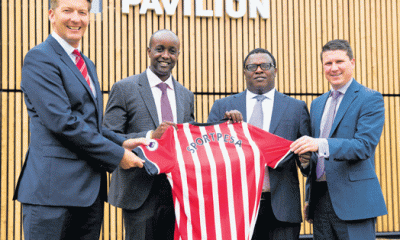Opinion
Gen Z Push for More Customer-Centric Approach to Banking

By Nohaila Ibn ElFarouk
Traditional banks are quickly being forced out of their comfort zone. This is not only because of advancements in technology and fierce competition from neobanks, but also because Gen Z has now come of age. Zoomers, as they are commonly referred to, were born between 1997 and 2012 and have brought a completely new set of expectations to the banking industry. Accustomed to instant, convenient services, their need for a more customer-centric approach to payments and finance continues to change the future of banking.
As early as 2025, zoomers will represent 27% of the global workforce, while Nigeria alone is home to 44 million members of Gen Z, quickly becoming a force that cannot be ignored.
Financially, they are the most optimistic generation on record, with a global study showing that 71% believe they will one day be financially stable, while 41% “see their financial provider as a partner in helping them reach their financial goals”.
Within Africa, they are leading the mobile money revolution even more than their millennial predecessors, with zoomers using mobile payment platforms 80% more often than older generations. They are interested in more sophisticated financial tools earlier on than older cohorts, with 40% of African Gen Z reporting using investment platforms like Chaka and Cowrywise. As they grow older and increase wealth, zoomers will become a major force in the continent’s finances, while maintaining their ingrained interest for digital, customer-centric solutions for moving money.
With the proliferation of tech-driven trends in the banking market, as well as increased consumer expectations, banks find themselves needing to up their game by offering more than only financial services. Instead, their services must now include integrated platforms – or better yet, an integrated ecosystem that includes not only mobile or wallet applications, but also integrates lifestyle capabilities that are more in line with the customer lifecycle. Gen Z are digital natives and expect apps to offer a seamless experience more akin to the digital service they are familiar with, rather than the somewhat arcane workings of a conventional bank.
For example, unlike regular banking apps that only offer basic services such as account management and long-term savings solutions, technology advancements have ensured that features such as saving pots and budgeting tools can now be integrated. Better still, e-commerce as well as third-party integrations that enable direct-to-brand shopping experiences and access to products such as insurance are essential, as they add more value to customer experiences.
A leading example in Africa is Mauritius Commercial Bank’s (MCB) Juice platform, recently enhanced with the launch of Juice Tap. Leveraging NFC technology, Juice Tap enables seamless contactless payments while allowing customers to pool their MCB accounts in one place, with integration options for external bank accounts. It also provides streamlined bill management and a secure digital wallet, catering to the demand for comprehensive and convenient banking solutions.
And it’s not just zoomers who see the appeal in this. Users of all ages adjust rapidly to the convenience of such integrated experiences and sometimes migrate to a new platform that offers increased ease and accessibility.
To thrive in this new era, banks must rethink their operational models and technology strategies. The shift goes beyond digitizing existing services; it requires reimagining how financial services are delivered altogether. One transformative approach is composable banking—a modular framework that allows banks to build flexible, customer-centric solutions at scale.
Composable banking enables financial institutions to move away from siloed, rigid systems and toward unified, adaptable architectures. This approach empowers banks to innovate faster, integrate cutting-edge technologies, and create tailored customer experiences. For Gen Z, this means access to intuitive, real-time services that fit seamlessly into their digital ecosystems. For banks, it’s a chance to reduce costs, increase agility, and future-proof their operations in an increasingly competitive market.
Banks can achieve significant transformation through unified banking platforms. These platforms enable composability, making it easier to integrate third-party solutions and bring new services to market quickly. With faster time-to-market and reduced complexity, banks can stay agile and address the needs of digitally native customers. Unified platforms also support personalized customer journeys, ensuring banks remain relevant to younger generations demanding tailored experiences.
Banks that embrace composable banking are positioning themselves to not only capture the loyalty of younger consumers but also redefine their role in a highly competitive market. The future of banking is not just about adapting to today’s expectations but anticipating tomorrow’s.
Nohaila Ibn ElFarouk is a Business Development Manager at Backbase, a Dutch banking software financial technology company and a global leader in engagement banking.
Kenya Insights allows guest blogging, if you want to be published on Kenya’s most authoritative and accurate blog, have an expose, news TIPS, story angles, human interest stories, drop us an email on [email protected] or via Telegram
-

 News6 days ago
News6 days agoTemporary Reprieve As Mohamed Jaffer Wins Mombasa Land Compensation Despite Losing LPG Monopoly and Bitter Fallout With Johos
-

 Sports5 days ago
Sports5 days ago1Win Games 2025: Ultimate Overview of Popular Casino, Sports & Live Games
-

 Investigations6 days ago
Investigations6 days agoFrom Daily Bribes to Billions Frozen: The Jambopay Empire Crumbles as CEO Danson Muchemi’s Scandal-Plagued Past Catches Up
-

 Business2 days ago
Business2 days ago‘They’re Criminals,’ Popular Radio Presenter Rapcha The Sayantist Accuses Electric Bike Firm Spiro of Fraudulent Practices
-

 Business6 days ago
Business6 days agoHass Petroleum Empire Faces Collapse as Court Greenlights KSh 1.2 Billion Property Auction
-

 Investigations2 weeks ago
Investigations2 weeks agoHow SportPesa Outfoxed Paul Ndung’u Of His Stakes With A Wrong Address Letter
-

 News6 days ago
News6 days agoShanta Gold’s Sh680 Billion Gold Discovery in Kakamega Becomes A Nightmare For Community With Deaths, Investors Scare
-

 Investigations2 weeks ago
Investigations2 weeks agoInside the Deadly CBD Chase That Left Two Suspects Down After Targeting Equity Bank Customer Amid Insider Leak Fears


















